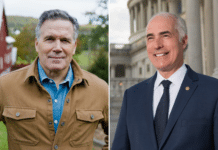
(Daily Caller News Foundation) — Dr. Susan Bradley, a Canadian psychiatrist and pioneer in child gender dysphoria treatment, came out against the popular model of affirming children’s transgender identities and putting them on puberty blockers — a practice she was once involved in — in an interview with the Daily Caller News Foundation.
Bradley started a pediatric gender clinic in 1975 aimed at treating children with gender dysphoria — a deep sense of discomfort with one’s body and biological sex — in which she offered a therapy-focused approach; most patients outgrew their feelings of being transgender over time, she told the DCNF. Around 2005, the clinic began prescribing puberty blockers to gender-dysphoric children as a way to alleviate their distress, a model which has since become widely adopted by medical establishments around the world, including in the U.S.
Bradley, who is now in her early eighties, expressed regret that the clinic had participated in the administration of puberty blockers for gender dysphoria, which she now believes can cement a child’s sense of confusion out of which they would likely otherwise grow. She also expressed concern about the drugs’ side effects.
“We were wrong,” she said. “They’re not as irreversible as we always thought, and they have longer term effects on kids’ growth and development, including making them sterile and quite a number of things affecting their bone growth.”
While most children who experienced gender dysphoria typically grew out of it and came to accept their bodies and gender prior to the widespread implementation of the “gender affirmation” approach, numerous doctors expressed concerns that puberty blockers made children’s temporary gender confusion permanent by solidifying their sense of actually being the opposite sex, according to The New York Times. The drugs also prevent the surge in bone density that would normally occur during puberty, with some patients experiencing lifelong bone issues. The FDA also identified six cases where there was a “plausible” link between GnRH agonists and a condition called pseudotumor cerebri, which is caused by elevated fluid pressure in the brain.
Bradley told the DCNF her opinions on puberty blockers evolved over time.
“We thought that it was relatively safe, and endocrinologists said they’re reversible, and that we didn’t have to worry about it. I had this skepticism in the back of my mind all the time that maybe we were actually colluding and not helping them. And I think that’s proven correct in that, once these kids get started at any age on puberty blockers, nearly all of them continue to want to go to cross sex hormones,” Bradley said.
Bradley opened the Clarke Institute of Toronto’s Child Youth and Family Gender Identity Clinic (GIC) in 1975, and she went on to become the head of Child Psychiatry at the Hospital for Sick Children and the psychiatrist-in-chief and head of the Division of Child Psychiatry at the University of Toronto.
“An opinion from someone like Dr. Bradley has enormous potential to influence debate because she is what Cass Sunstein has called a ‘surprising validator,’” Joseph Burgo, psychotherapist and vice director of Genspect, told the DCNF. “It’s human nature to dismiss even well-reasoned arguments and credible evidence from those who are readily identified as on the other side, as ‘them’ — say, Republicans, or well-known ‘transphobes.’ But Dr. Bradley is a pioneer in the field and politically unaligned.”
“She does not argue that puberty blockers are never appropriate. Instead, she urges a cautious exploratory approach to gender distress based upon her decades of experience,” Burgo said. “When a professional who might have been expected to align with one side (affirmative care) issues a nuanced opinion and urges caution, it can help members of the public not to takes side against her, to polarize and dismiss her opinions, but instead to open their minds to alternative points of view. Surprising validators like Dr. Bradley can soften divisions and promote dialog even more than well-balanced presentations with arguments from both sides can do.”
Bradley believes transitioning is beneficial for some adults and says some patients consider it the best thing they’ve ever done for themselves, but that the metrics of success, even in terms of patient satisfaction, are complicated. One of her patients transitioned from female to male, married a woman who had been a childhood friend and seemed happy and satisfied, but later in life pursued a very costly phalloplasty surgery; despite appearing “very masculine,” the patient was never fully satisfied and was always pursuing further bodily improvements, according to Bradley.
Another patient Bradley worked with transitioned from male to female but eventually told the psychiatrist he was no longer trans and was in a relationship with another man. This made Bradley question if transitioning was really just about seeking acceptance for some patients.
“It made me realize that what we’re really talking about is acceptance that they need; we all need somebody who loves us,” Bradley said. “And so it’s very complicated. There are people who make this work. But there are an awful lot of people who end up feeling that this hasn’t solved their problems with who they are and what they are … the long and short of it is that the decision was made at a time when these kids were just too young to really know how they were going to make this work. And that’s not fair.”
Bradley chaired the Subcommittee on Gender Dysphoria for the fourth edition of the Diagnostic and Statistical Manual of Mental Disorders (DSM), the official manual of the American Psychiatric Association, which is used for classifying and diagnosing mental disorders. She led eight other doctors in determining diagnostic guidelines for gender identity disorders.
She also produced research, along with other clinic doctors, showing that 87.8% of boys referred to their clinic for gender identity issues eventually “desisted,” meaning they stopped believing they were actually girls and came to terms with their sex.
Bradley came to believe that most child patients who identified as transgender were actually on the autism spectrum or suffering from borderline personality disorder, which she believes should be classified as part of the autism spectrum. Autistic adolescents are particularly prone to obsessive thinking and body image issues, and they struggle to change their minds once convinced something is true, all of which make them more vulnerable to being convinced they are actually the opposite sex and should seek medical interventions such as puberty blockers or hormones.
“You have to put yourself in the place of a 12 year old or a 13 year old, who is thinking, ‘This is my way to get normal,’” Bradley said. “These kids are not faring well with the current affirmative approach. I don’t know that any kids actually could, given the capacity of a 10 or 12, or even 14 or 15 year old to understand the complexity of the decision that they’re making on their long term sexual and life function. It just doesn’t make sense.”
The GIC was shut down following Bradley’s 2007 retirement amid intense pressure from transgender activists who believed that the clinic, which did not automatically affirm children’s gender identity or transgender status, was transphobic.
Skepticism of puberty blockers has grown in recent years amid high-profile scandals involving pediatric gender clinics prescribing blockers to halt the healthy puberty of children as young as 10 with allegedly inadequate psychological screening. Stella O’Malley, psychotherapist and founder of Genspect, an organization that is critical of childhood gender transitions, voiced concerns about the intervention in a previous interview with the DCNF.
“Blocking the sexual development of children is a highly authoritarian intervention. Children are asexual, and so they can’t understand the impact of impaired sexual functioning,” she said. “We are roughly 10 years into this large-scale experiment and already we have reports on issues with cognitive development, bone mineral density, and fertility. All the up-to-date evidence shows that puberty blockers are neither safe nor reversible.”
Advocates for medical gender transitions for children argue that puberty blockers can diminish the distress a gender dysphoric child experiences as a result of puberty and can reduce the need for later surgeries or hormonal interventions by preventing the acquisition of some traits associated with their biological sex, such as a deep voice in a male patient.
“Anxiety drains away,” Dr. Norman Spack, a leader in the push for puberty blocker use in gender dysphoric patients, told The New York Times. “You can see these kids being so relieved.”
The Center for Addiction and Mental Health, formerly the Clarke Institute of Toronto, did not respond to the Daily Caller News Foundation’s request for comment.

















